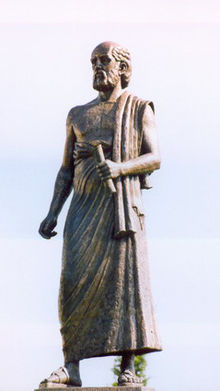Aristarchus of Samos | |
|---|---|
 Statue of Aristarchus of Samos at the Aristotle University of Thessaloniki | |
| Born | c. 310 BC |
| Died | c. 230 BC (aged around 80) |
| Nationality | Greek |
| Occupations | |
Aristarchus of Samos (/ˌærəˈstɑːrkəs/; ‹See Tfd›Greek: Ἀρίσταρχος ὁ Σάμιος, Aristarkhos ho Samios; c. 310 – c. 230 BC) was an ancient Greek astronomer and mathematician who presented the first known heliocentric model that placed the Sun at the center of the universe, with the Earth revolving around the Sun once a year and rotating about its axis once a day. He also supported the theory of Anaxagoras according to which the Sun was just another star.[2]
He likely moved to Alexandria, and he was a student of Strato of Lampsacus, who later became the third head of the Peripatetic School in Greece. According to Ptolemy, he observed the summer solstice of 280 BC.[3] Along with his contributions to the heliocentric model, as reported by Vitruvius, he created two separate sundials: one that is a flat disc; and one hemispherical.[4]
Aristarchus was influenced by the concept presented by Philolaus of Croton (c. 470 – 385 BC) of a fire at the center of the universe, but Aristarchus identified the "central fire" with the Sun and he arranged the other planets in their correct order of distance around the Sun.[5]
Like Anaxagoras before him, Aristarchus suspected that the stars were just other bodies like the Sun, albeit farther away from Earth. His astronomical ideas were often rejected in favor of the geocentric theories of Aristotle and Ptolemy. Nicolaus Copernicus knew that Aristarchus had a 'moving Earth' theory, although it is unlikely that Copernicus was aware that it was a heliocentric theory.[7][8]
Aristarchus estimated the sizes of the Sun and Moon as compared to Earth's size. He also estimated the distances from the Earth to the Sun and Moon. He is considered one of the greatest astronomers of antiquity along with Hipparchus.
- ^ "Aristarchus of Samos: Mathematician and astronomer". World History. 8 September 2015. Archived from the original on 7 May 2018. Retrieved 29 November 2018.
- ^ [1]
- ^ Huxley, George (30 May 1964). "Aristarchus of Samos and Graeco-Babylonian Astronomy". Greek, Roman, and Byzantine Studies. 5 (2): 123–131. ISSN 2159-3159.
- ^ Sidoli, Nathan Camillo (22 December 2015). "Aristarchus (1), of Samos, Greek astronomer, mathematician, 3rd century BC". Oxford Classical Dictionary. doi:10.1093/acrefore/9780199381135.013.737. ISBN 978-0-19-938113-5. Retrieved December 7, 2021.
- ^ Draper, John William (2007) [1874]. "History of the Conflict Between Religion and Science". In Joshi, S. T. (ed.). The Agnostic Reader. Prometheus. pp. 172–173. ISBN 978-1-59102-533-7.
- ^ a b Owen Gingerich, "Did Copernicus Owe a Debt to Aristarchus?", Journal for the History of Astronomy, vol. 16, no. 1 (February 1985), pp. 37–42. "There is no question but that Aristarchus had the priority of the heliocentric idea. Yet there is no evidence that Copernicus owed him anything.(!9) As far as we can tell both the idea and its justification were found independently by Copernicus."
- ^ The Greek mathematician and astronomer Aristarchus of Samos proposed such a system during the third century BC (Dreyer 1953, pp. 135–48). In an early unpublished manuscript of De Revolutionibus (which still survives in the Jagiellonian Library in Kraków), Copernicus wrote that "It is credible that... Philolaus believed in the mobility of the Earth and some even say that Aristarchus was of that opinion", a passage that was removed from the published edition, a decision described by Owen Gingerich as "eminently sensible" "from an editorial viewpoint".[6] Philolaus was not a heliocentrist, as he thought that both the Earth and the Sun moved around a central fire. Gingerich says that there is no evidence that Copernicus was aware of the few clear references to Aristarchus's heliocentrism in ancient texts (as distinct from one other unclear and confusing one), especially Archimedes's The Sand-Reckoner (which was not in print until the year after Copernicus died), and that it would have been in his interest to mention them had he known of them, before concluding that he developed his idea and its justification independently of Aristarchus.[6]
- ^ For a (less recent) contrary view that Copernicus did know about Aristarchus's heliocentric theory see: George Kish (1978). A Source Book in Geography. Harvard University Press. pp. 51–52. ISBN 978-0-674-82270-2.
Copernicus himself admitted that the theory was attributed to Aristarchus, though this does not seem to be generally known... Here, however, there is no question of the Earth revolving around the sun, and there is no mention of Aristarchus. But it is a curious fact that Copernicus did mention the theory of Aristarchus in a passage which he later suppressed:
The Philolaus-Aristarchus passage is then given in untranslated Latin, without further comment. This is then followed by quoting in full Archimedes's passage about Aristarchus's heliocentric theory from 'The Sand Reckoner' (using its alternative title Arenarius)', seemingly without mentioning that The Sand Reckoner was not in print until a year after Copernicus's death (unless this is mentioned in a passage not shown by Google Books.).